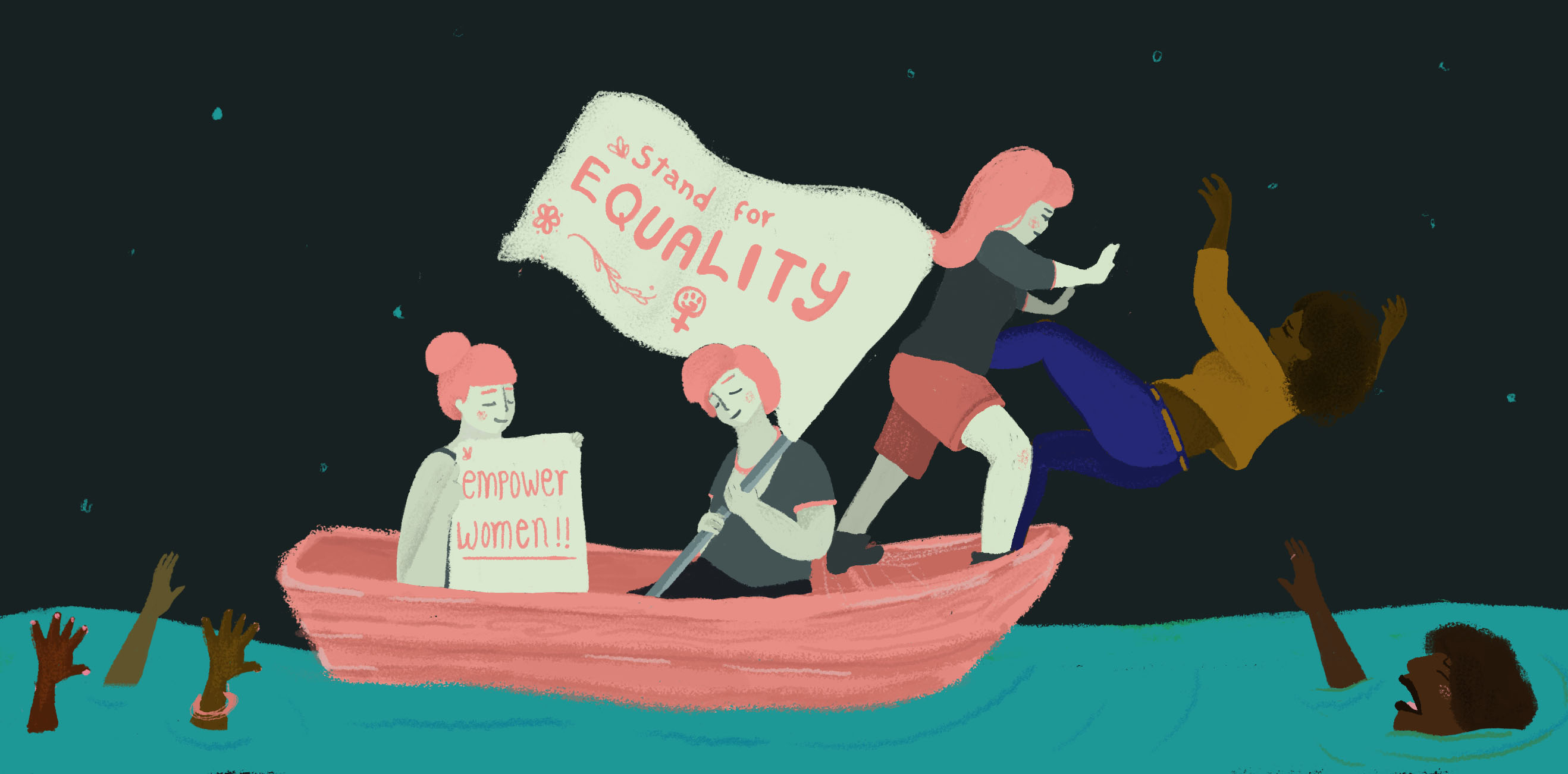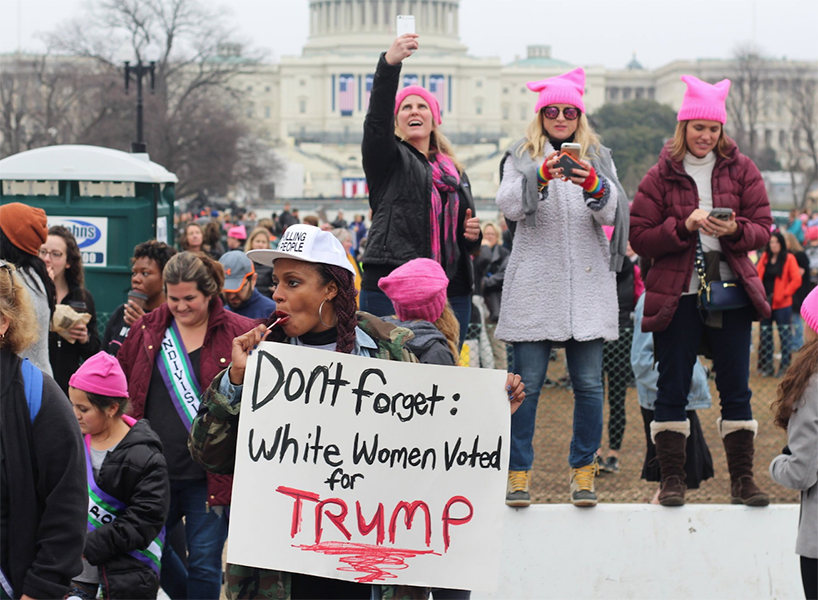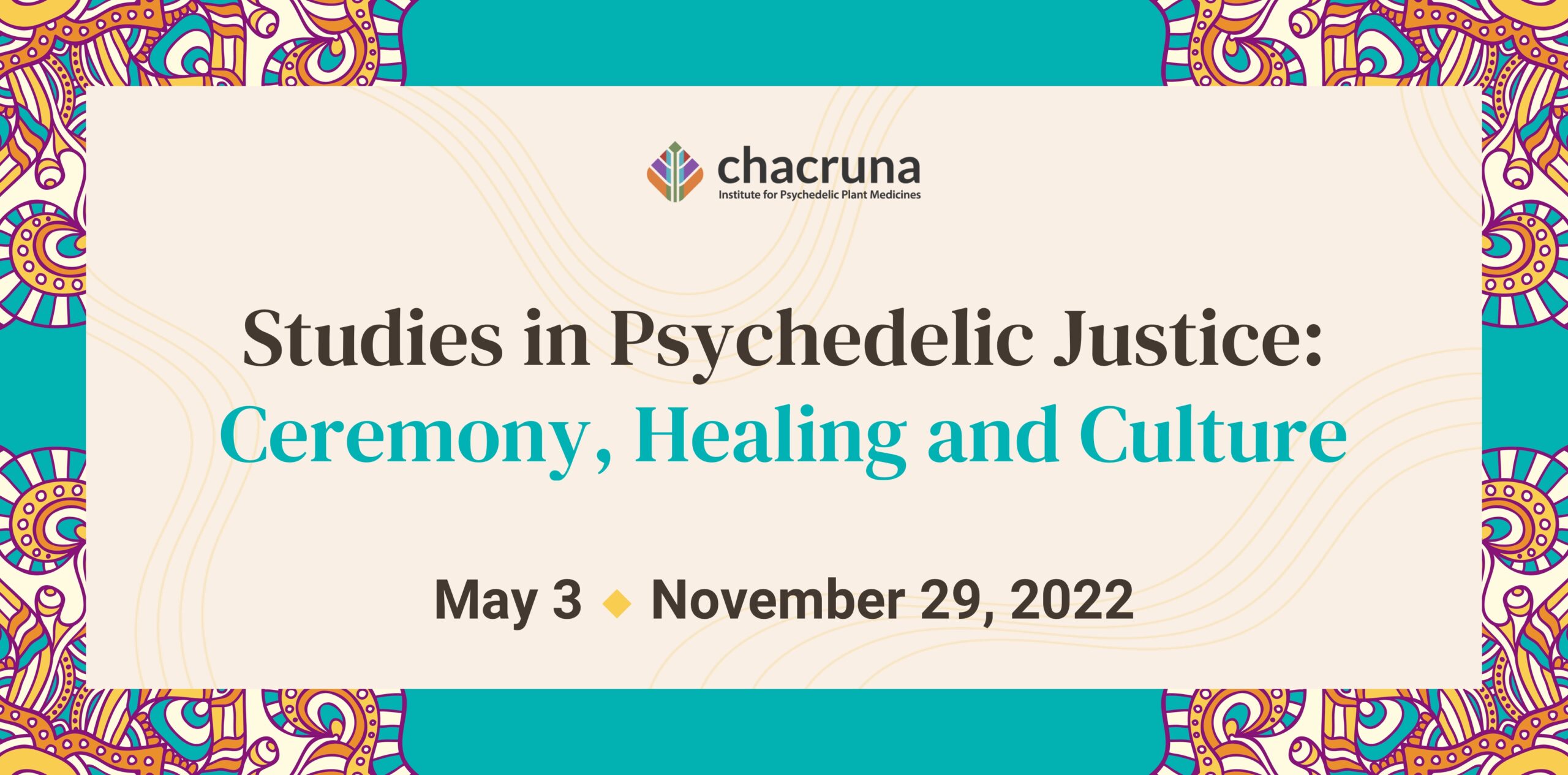In November, I participated in a panel discussion at a psychological conference in Washington DC. The name of the panel was Being a Mentor in the Era of #Metoo, which seemed extremely timely given the spate of powerful people recently felled by revelations of sexual wrongdoing. As the only person of color on the panel, I wanted to make sure to mention some of the issues around this movement that singularly impacted people of color. The #metoo movement included a responsibility for privileged women to stop victimizing men of color, many of whom have been lynched, beaten, incarcerated, and electrocuted on the false whisper of a White woman. I had recently supported a member of our research team who ended up in such a predicament, and so this point felt particularly real for me at the moment.
As I shared my observations and convictions, I was abruptly cut off by the moderator, a senior academic White feminist. The mic was taken from me, a woman of color, and handed to a White woman who had her own personal story of oppression to share. I was silenced, my uncomfortable words forgotten, and I became irrelevant. At the podium, the moderator affirmed her lifelong commitment to feminist ideals, while I was shamed into submission. This is White Feminism.
Understanding White Feminism
it is a racist ideology that claims to speak for all women while ignoring the needs of women of color and suppressing our voices
True feminism has the power to transform society, but too often what is advanced as feminism is actually White supremacy in disguise – a counterfeit we sometimes call White Feminism. White Feminism exists to promote the comfort and safety of middle-class and affluent White women. At its core, it is a racist ideology that claims to speak for all women while ignoring the needs of women of color and suppressing our voices when our agendas and priorities don’t align. It recognizes the voice of women of color only to further its own aims and appear inclusive (Ortega, 2006). Its organizational representations fail to properly address racial and economic intersectionality in experiences of sexism. It rejects the idea that women can oppress others who are disempowered and, in doing so, replicates the harmful unacknowledged social dynamic of the primacy of well-educated White voices.
As a researcher and educator, and I have seen White Feminism at work in nearly every facet of my career. My current research areas include mental health disparities, racism and discrimination, trauma, obsessive-compulsive disorder, and the emerging field of psychedelic medicine. In the psychedelic world, I am repeatedly expected to give talks nationwide at my own expense. And, even though I have conducted multiple research studies, written books, and published dozens of articles in top journals, I find it interesting that I have virtually no White women faculty collaborators. White women friends: a few; supporters: many; junior colleagues: several; but collaborators: none. Those same women who applaud the advances of women in academia will not collaborate, share mutual resources, or celebrate the achievements of a Black woman. Further, I find many White female graduate students and clinical trainees chafe against having to answer to a Black woman, and female administrators frequently ignore or undermine my needs.
When I was invited by White female colleagues to the Women’s March last year, I made an excuse not to go. I didn’t want to be a token for a group that doesn’t seem invested in women like me. Since that time, I’ve spoken to many other women of color who felt the same way but didn’t know how to put words to their feelings. So, to that end, I am putting words to it now — and facts and figures too. I have complied some examples of White Feminism and how it misses the needs of Black women and other disempowered women.
Black women are dying in childbirth. Maternal mortality for Black women is four times the rate of White women, and these rates remain high even for middle- and upper-class Black Women. Even though the US spends more on childbirth than anywhere else, it’s safer for a Black woman to have a baby in sub-Sahan Africa than in a modern hospital in Arkansas. Rates have been climbing for all women since 2000, and, bizarrely, no one seems to care.
It fails to fight for paid maternity leave, since perhaps White women can afford to stay at home with their babies without a paycheck. We lag far behind most developed nations when it comes to maternity leave. The Trump administration has been interested in making modest gains in this area (six weeks guaranteed paid leave), with nary a peep of support from anyone on the right or left. Those on the right are concerned about the cost, while those on the left criticize the plan’s shortcomings. It’s a step in the right direction, and it is shameful and outrageous that feminists are not clamoring for this low-hanging fruit.
It appropriated #metoo, while failing to acknowledge how White women have historically (and currently) used their sexuality to oppress men of color.
It appropriated #metoo, while failing to acknowledge how White women have historically (and currently) used their sexuality to oppress men of color. Many Black men sit in prison on false rape charges or face great social loss due to such accusations. When White women cry rape, our society mobilizes to punish the targets, guilty or not, to protect White women’s virtue. The tragic case of Emmett Till and the Tulsa Oklahoma Race Massacre are catastrophic examples of this. Emmett Till, a 14-year-old African American boy, was lynched for purportedly propositioning a White woman in a store; his accuser, Carolyn Bryant, recanted decades later, but it was too late for Emmett. And, in one of the largest acts of domestic terrorism ever, the prosperous Black community of Greenwood, Oklahoma was burned down and firebombed after a White woman claimed a Black man frightened her on an elevator.
It thinks it’s ok to take paternalistic control over Black women and girls’ sexual choices. Pregnancy and sexuality are socially constructed as problematic and managed, controlled, and regulated depending on social status.1 Black women and girls are disproportionately given birth control injections, implants, and the intrauterine device (IUD’s) over options they can control themselves.2 I remember very clearly after the birth of my oldest daughter, a nurse barging into my hospital room while I was half-asleep recovering from labor. She insisted I start taking progestin contraceptives, and then stormed out when I didn’t give in. Not only did she ignore my concerns, but this conversation should have happened while I was awake and in a place where we could have a careful discussion about my needs and choices.
It regards Black women’s children as disposable. Black women’s babies die at twice the rate of White women’s,3 and these rates remain the same when controlling for income and education. Reviewing infant mortality globally, babies born in countries like Panama fare better than Black babies born in the US. Additionally, Black and indigenous children are taken from their mothers at higher rates than from White mothers. Black children continue to be targets throughout their lives until they are old enough to fill prisons, with Yale researchers documenting teachers racially profiling Black children starting in preschool.4
It has no clue how punishing and patronizing health care can be for women of color. Research shows that doctors have biases against Black patients and are less likely to engage in cooperative, patient-centered care. Doctors speak faster, dominate conversations, end visits sooner, and display fewer positive cues and less warmth, translating to lower quality health care for people of color.5 There is almost no quantitative research on how this is uniquely experienced by women of color, perhaps underscoring what a low priority the quality of our medical interactions is to researchers and funders. But we do know that breast cancer and cervical cancer mortality is 40% percent higher in Black women than in White women. And Black people are routinely undertreated for pain, undertreated for anxiety and depression, and over-diagnosed with psychosis.
It opposes regulation to make abortion safer, since they’ll never need to use a low-income clinic; this did not work out so well for women of color in Philadelphia. When I was a junior faculty at the University of Pennsylvania, I walked past Dr. Kermit Gosnell’s little shop of horrors daily, and had no idea what was occurring inside. He performed from four to five illegal late term abortions per week, while unqualified (even teenage) staff provided anesthesia in filthy conditions. Despite dozens of complaints, injuries, and life-threatening emergencies, no hospitals made the required reports to state health agencies, and state health agencies refused to investigate the reports that they did receive until after two women died. How did this happen? In 1993, the Pennsylvania Department of Health decided to stop inspecting abortion clinics at all. Where is all the feminist outrage over such deplorable oversight and those women’s tragic and preventable deaths? A grand jury concluded that no one acted sooner because “the women in question were poor and of color, because the victims were infants without identities, and because the subject was the political football of abortion.” This is a particularly troubling example of how White Feminism builds its agenda atop our injured and dead bodies.
I was offered sterilization by the obstetrician, and not once, but three different times during three different deliveries
It ignores the problem of forced and coerced sterilization because disempowered Black, Brown, and indigenous women and inmates are targeted in this eugenicist manner, not “good White women”.6 7 I have seen a small piece of this coercion myself. While in the process of giving birth, I was offered sterilization by the obstetrician, and not once, but three different times during three different deliveries. My last delivery was long and difficult because my water broke five and half weeks early, and I endured prolonged labor as the baby was not ready to emerge. I was vomiting and having semi-conscious nightmares from the anesthetic while worried about my baby, and I don’t even remember if I agreed to the sterilization or not. This did not happen in a prison, and I was not a low-income single mother. I was a faculty member at Penn, giving birth at Bryn Mawr Hospital, with my husband beside me. Imagine how much harder this would be for a woman of color with far fewer resources.
It ignores oppression inflicted by the criminal justice system. Consider the shocking facts that 60% of women in jail have not been convicted of a crime and are awaiting trial, 80% of women in jail are single mothers, and two-thirds are women of color. A third are suffering from major mental illness. Incarceration rates are increasing; Hispanic women are incarcerated at nearly twice the rate of White women, and Black women are incarcerated at four times the rate of White women. Health care is inadequate for incarcerated women and, as noted, their reproductive rights are routinely violated. I can only assume this problem is not prioritized because White Feminists don’t worry about going to jail, as they can afford good legal representation and bail, and are not targeted by law enforcement. Further, when White women are assaulted and call the police, the police will almost always help them. For Black women, this is not always true (and has not been true for me).
indigenous women are disappearing and no one is looking for them.
It doesn’t care that indigenous women are disappearing and no one is looking for them. There is a really disturbing pattern of missing and murdered Native American women and girls throughout North America, and families can’t get authorities to help find them. Apparently, these especially vulnerable women can be abused and murdered with no consequences at all.
It is extremely fragile around issues of race. White Feminism weaponizes White women’s tears in order to silence observations of racism.8 White women merely need to cry when called out on racism and hypocrisy to villainize people of color, thereby centering the conversation on the emotional well-being of White women, rather than harms done.9 Further, it hides its White privilege behind female or LGBTQ oppression, as experiences of sexism and homophobia become an excuse to avoid working on their personal racial biases.
Summary
It’s hard to muster up energy to fight issues like the infamous wage gap when so many of my amazing sisters of color can’t get decent medical care, our babies are dying at rates typical of developing countries, our partners are sitting jail for no good reason at all, and we are all traumatized from living in a racist society. These are my priorities, and if you care about all women, these should be your priorities too.
White Feminism is so distasteful that many women of color want nothing to do with the feminist label, period. Alice Walker devised the term womanism to define her love of Black womanhood and a commitment to improved lives for all people oppressed due to race or class. White Feminism is part of our oppression. When it comes to feminism in America, women of color simply don’t have a seat at the table, and when we do, it’s for illusion of inclusivity and not because our differing perspectives have value. This is called tokenism: including someone from our demographic to keep up appearances when, in fact, we have no say or power. And when we are “heard,” our voices and stories are (mis)used to further White Feminist goals.
A few years ago, I declined an invitation to give a keynote address at a major national feminist conference. It is tempting to think I could have used this platform to enlighten my White feminist sisters, but it would be a mistake to assume they are unaware of these issues.10 When I recently posed these problems to a White Feminist philosophy professor, she was well aware of it, and said they were frequent topics of discussion in her classes. Therefore, I can only conclude that feminist groups don’t care to do anything differently, making it difficult for me to believe that the women’s movement has any good intentions for Black people whatsoever. Based on the agenda of national women’s organizations, it appears that White Feminist leaders have sold out to the priorities of the medical industry (run by White male doctors), big pharma, and other corporate interests (more wealthy White men). White Feminist leaders are, in fact, engaging in silent collusion with our oppressors. Figuratively and literally, they are bed together, while women of color get the shaft.
Racism is embedded in both liberal and conservative procedures and ideologies, and is even at the core of our vaunted women’s movement
We cannot claim to be immune from racism simply because we are “good progressive liberals.” Racism is embedded in both liberal and conservative procedures and ideologies, and is even at the core of our vaunted women’s movement. This brand of feminism does not speak for me. Let’s call out racism wherever it lies.
Art by Karina Alvarez.
References
- Brubaker, S. J. (2016). Denied, embracing, and resisting medicalization: African American teen mothers’ perceptions of formal pregnancy and childbirth care. Gender & Society, 21(4), 528– 552. 10.1177/0891243207304972 ↩
- Dozier, A. M., Nelson, A., Brownell, E. A., Howard, C. R., & Lawrence, R. A. (2014). Patterns of postpartum depot medroxyprogesterone administration among low-income mothers. Journal of Women’s Health, 23(3), 224–230. doi:10.1089/jwh.2012.4016 ↩
- Collins, J. W., David, R. J., Handler, A., Wall, S., & Andes, S. (2004). Very low birthweight in African American infants: The role of maternal exposure to interpersonal racial discrimination. American Journal of Public Health, 94(12), 2132–8. ↩
- Gilliam, W. S, Maupin, A. N., Reyes, C. R., Accavitti, A., & Shic, F. (2016, September 28). Do early educators’ implicit biases regarding sex and race relate to behavior expectations and recommendations of preschool expulsions and suspensions? Yale University Child Study Center. Research Study Brief. Retrieved from https://medicine.yale.edu/childstudy/zigler/publications/Preschool%20Implicit%20Bias%20Policy%20Brief_final_9_26_276766_5379_v1.pdf ↩
- FitzGerald, C., & Hurst, S. (2017). Implicit bias in healthcare professionals: A systematic review. BMC Medical Ethics, 18(19), 1–18. https://doi.org/10.1186/s12910-017-0179-8 ↩
- California State Auditor. (2014). Sterilization of female inmates: Some inmates were sterilized unlawfully, and safeguards designed to limit occurrences of the procedure failed. Report 2013-120. Retrieved from https://www.auditor.ca.gov/pdfs/reports/2013-120.pdf ↩
- Stern, A. M. (2005). STERILIZED in the name of public health: Race, immigration, and reproductive control in modern California. American Journal of Public Health, 95(7), 1128–1138. http://doi.org/10.2105/AJPH.2004.041608 ↩
- Accapadi, M. M. (2007). When White women cry: How White women’s tears oppress women of color. College Student Affairs Journal, 26(2), 208–215. ↩
- DiAngelo, R. (2011). White fragility. The International Journal of Critical Pedagogy, 3(3), 54–70. ↩
- Ortega, M. (2006). Being lovingly, knowingly ignorant: White feminism and women of color. Hypatia: A Journal of Feminist Philosophy, 21(3), 56–74. ↩
Take a minute to browse our stock:
Did you enjoy reading this article?
Please support Chacruna's work by donating to us. We are an independent organization and we offer free education and advocacy for psychedelic plant medicines. We are a team of dedicated volunteers!
Can you help Chacruna advance cultural understanding around these substances?

















